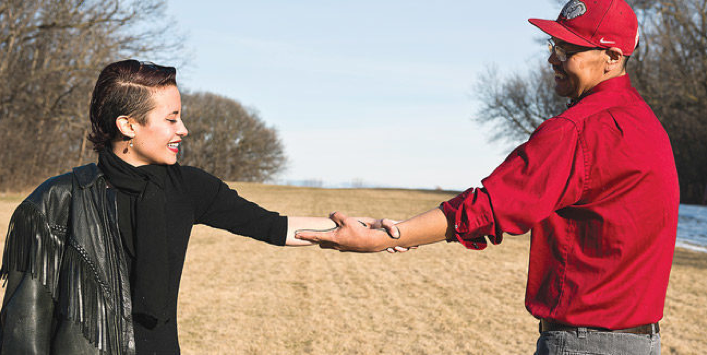 Patty and Dereck Stonefish, the founders of Arming Sisters/Reawakening Warriors, were featured in a Restorative Narrative by ivoh fellow Christa Hillstrom. (Photo by Dan Koeck/YES! Magazine)
Patty and Dereck Stonefish, the founders of Arming Sisters/Reawakening Warriors, were featured in a Restorative Narrative by ivoh fellow Christa Hillstrom. (Photo by Dan Koeck/YES! Magazine)
Engagement, empowerment and resilience — concepts integral to restorative practices — are also informing the development of a new genre of media and journalism called Restorative Narrative. Images of Voices and Hope (ivoh), a nonprofit that will present at the IIRP World Conference in October, believes that Restorative Narratives can enable media to create meaningful, positive change in the world.
Through its website, fellowship program and events, ivoh delves into the nature of Restorative Narrative – stories that demonstrate the resilience of individuals and communities. For example, a recent article on ivoh’s website examines how some media practitioners are addressing race-related violence in ways that “offer more room for dialogue, unity and healing” – an approach that will resonate with restorative practitioners.
For the past three years, ivoh has offered six-month fellowships to five media practitioners already working in the genre. The program provides support and space for its fellows to dialogue, learn more about how to structure their narratives and become aware of pitfalls through workshops and coaching from Pulitzer Prize winner and University of Missouri Knight Chair in Journalism professor Jacqui Banaszynski.
Mallary Tenore, director of ivoh since 2013, explains that many media practitioners are sympathetic to the idea of doing reporting that really can help people and communities, but their editors and managers don’t always allow it. The fellowship program helps practitioners develop a story project to completion, which ivoh can then share as an example of the genre.
2016 fellow Christa Hillstrom, who is also a senior editor at Yes! Magazine, reported the story of a Native American woman who was a victim of sexual abuse. She now teaches self-defense as a means of reclaiming her own sense of self and helping other women avoid and recover from abuse.
2015 fellow Evasta Hansey wrote a story of a teen mother living in poverty in Cincinnati, Ohio. She got a big break when she landed a secretarial job at the St. Vincent de Paul Society, was promoted to a managerial position and then started a weekly “sister circle” to support other teen mothers like herself. Eventually she became a pastor.
Tenore is quick to clarify that Restorative Narratives don’t always tie things up with a pretty bow. Each of the women in these stories continues to experience struggles with finances or maintaining healthy relationships. But Restorative Narratives celebrate their struggles by detailing “a meaningful progression from a place of despair to a place of resilience without shying away from the messy middle,” says Tenore.
ivoh supports experimental media, as well. 2016 fellow Dan Archer — who is also a featured presenter at the IIRP World Conference — is a graphic comic artist/journalist who recently developed a virtual reality app. The app uses 3D graphics and actor-read eyewitness accounts to let users experience a first-person point of view of the scene in Ferguson, Missouri, where police shot Michael Brown, whose death ignited the Black Lives Matter movement. Archer is currently preparing another app that will provide first-person accounts of the Colombian civil war. Members of a small village on both sides of the long conflict share their stories in face-to-face restorative justice meetings, as a means to healing.
Tenore explains that after the Newtown, Connecticut, school shooting, the organization came across a New Yorker article featuring Curtis Clark, the editor of the local newspaper, the Newtown Bee. Clark talked about the need for the paper to serve its community in the wake of the tragedy in a very different way than the national media frenzy, which exploited the town’s grief with a fury guided by the old motto, “if it bleeds, it ledes.” Clark argued that instead of reinforcing narratives of trauma and tragedy, the newspaper needed to create “redemptive narratives.”
ivoh, which had been convening conversations on alternative media narratives since 1999 and incorporated as a nonprofit organization in 2008, immediately recognized Clark’s point of view as fully consistent with its own. Riffing on the phrase “redemptive narrative,” ivoh coined the term “Restorative Narrative” and engaged Clark and others in the movement. “We didn’t invent the idea, but we gave it a name and a community of support around it,” Tenore explains. The group also hosts an annual media summit, with the next one taking place June 22-25, 2017 in New York state’s Catskill Mountains.
Tenore says she is looking forward to exploring some of the challenges and opportunities of Restorative Narrative at the IIRP World Conference: “I think it’s going to be really great to be in this restorative space and present to an audience that is really interested in restorative justice and restorative storytelling. We hope to make new connections and learn from the questions people ask us and the good feedback we get to help us think even more deeply about this subject.”
Mallory Tenore and colleague Paula Ellis will offer a featured session, “How Restorative Narratives Can Strengthen Media Coverage and Communities,” at Restoring Community: IIRP 21st World Conference. Dan Archer’s session is titled “Walk in Another’s (Virtual) Shoes: Immersive Approaches to Restorative Storytelling Through VR [virtual reality], AR [augmented reality] and Comics.”

